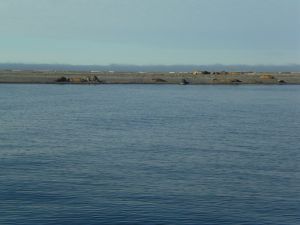
| Sunday 15 August |
|
"Philip, tea or coffee?" Peter's bawl from the galley is his third attemt to rouse me from deep sleep and I'm 15 minutes overdue for my 6am watch. It's hard to get used to the strange sleep/wake patterns of life aboard Imram. Conditions are just perfect for everything except sailing - brilliant sunshine, oily smooth sea, no wind and an air temperature of 15 degrees - a Spitsbergen heatwave! It's a rare treat to be able to breakfast on deck and not to have to wear 4 layers of clothing, 3 pairs of socks, 2 pairs of gloves and a wooly hat. We arrive at Moffen, a curious lagoon-encircling pseudo-atoll worthy of the South Pacific but perched here just above the 80th parallel. Not a sign of a coconut palm, just bare rock and sand, but it's the inhabitants that we have come here to see. For this is home to one of the largest walrus colonies on Spitsbergen. Just offshore we spot rounded shapes in the sea and suddenly everone is scrambling for binoculars, cameras and videos. Rob and Peter bring Imram close to the shore, but they are wary of disturbing the residents. In groups of up to 30 animals, most of them are sunbathing on the beach. The only sound is the clicking of camera shutters. Two or three of these "rock sausages" slip into the water and swim towards Imram. At one moment Salvatore's face is no more than 2 metres from the huge tusks of an enormous male, and with his 30 cm long telephoto lens he has trouble focussing that close. It's surprising to discover that these enormous mammals eat nothing larger than shellfish.
Apart from walruses, wildlife is surprisingly scarce up here. We've seen dolphins close to Imram on several occasions, the odd seal or two and rarely a glimpse of a whale. There must be reindeer here as we've come across some impressive sets of antlers, but no live ones. In Ny Alasund we saw one Arctic fox in summer colouring (brown and white) wandering along the beach. Sea birds, too, are far from numerous. Easily the most common are Fulmars, their stiff wings just skimming the waves. Next are the Little Auks, pigeon-sized black and white birds amazingly well adapted for survival in the icy waters of the Far North. We've also seen a few Puffins, Guillimots and Kittiwakes, too many of the dive-bombing Arctic Terns, and one or two of the ultra-agressive Arctic Skuas. Spitsbergen flowers are even more scarce, but this varies greatly from place to place. There have been small areas of tundra covered with colourful mosses and lichens, but on our last mountain walk (to the summit of Celsiusfell, 340m altitude), the total vegetative cover amounted to a patch the size of a table cloth down near the shore where the Svalbard Poppy, Moss Campion and Cassiope were thriving. This scarcity of flowers draws your attention to the immense variety of shape, size, colour and texture of the stones and pebbles. Even their spacial arrangement is strikng, as though some giant hand has spent ages arranging and rearranging them. This seems to be a permafrost effect, the ground being permanently frozen to a depth of 400 metres except for the top few centimetres that thaw out during each brief Svalbard summer, which leaves either a stoney surface or a spongy one with curious geometric patterns.
Précédent | Index 2004 | Suite de l'aventure - next adventure The Imram Voyage 2004 - Integral 12.50 - ACAPELA, juillet 2004 |

